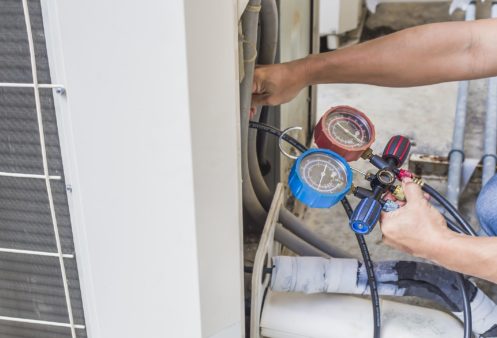Many people in Tucson, Arizona remember a time when sunbathing was actually good for you. Now, unless you’re slathered from head to toe in sunblock, excess sun exposure can wreak havoc on the health of your skin. This change is primarily due to the ongoing depletion of the earth’s ozone layer. This thin layer of the earth’s atmosphere absorbs the sun’s harmful UV rays and keeps people, plants, and animals protected. Sadly, the long-term use of R22 as a residential refrigerant is responsible for more than five decades of progressive ozone depletion. With R401A available as a more efficient, effective, and environmentally sustainable alternative, some consumers still have yet to make the switch.
How Is R401A Better for the Environment?
By composition, Freon, or R22, is a hydrochlorofluorocarbon (HCFC), which is a naturally ozone-depleting substance (ODS). Conversely, R401A is not. Also known as Puron, R401A is a hydrofluorocarbon (HFC). Although HFCs produce a moderate amount of greenhouse emissions, they do not deplete the ozone layer.
It’s important to note that there is a worldwide effort to end the use of HCFCs by 2030. With this initiative already underway in the United States in the form of an R22 phase-out, the ability to continue using R22 air conditioners and the Freon they require will invariably decrease over time.
There is also an ongoing effort to find additional alternatives to R401A. Several promising refrigerants are currently being researched. These are single-ingredient refrigerants that neither deplete the ozone layer nor produce greenhouse gases. However, their widespread adoption is still quite a long way off. In fact, all of the R401A air conditioners that are currently installed or soon to be installed will likely reach the end of their projected lifespans before any industry-wide changes are made. For now, R401A is being hailed as the new industry standard for AC refrigerant in residential applications, and it is definitely poised to remain that way for years to come.
Air Conditioners Benefit From R401A as Well
R401A isn’t just a more environmentally friendly AC refrigerant. It also represents a significant improvement in how air conditioners and their refrigerants perform. R401A works at higher pressure levels than Freon does. It has a vastly improved compressor lubricant in the form of a high-quality synthetic oil. It additionally has the ability to both absorb more heat during the cooling process and release more heat. Together, these changes limit the amount of wear that AC compressors are subjected to. AC compressors in air conditioners that use Puron are less likely to overheat and less likely to burn out.
Switching to R401A for Financial Reasons
The Environmental Protection Agency (EPA) implemented a plan for phasing out Freon that started in 2010. In 2010, AC manufacturers were prohibited from designing and producing new air conditioner models that required Freon for their cooling processes. As such, all residential air conditioners currently in use in the United States are more than 10 years old. Due to their increasingly advanced age, these models are more likely to experience recurring repair issues and more likely to develop refrigerant leaks. Given the less-than-superior performance of R22 in absorbing and releasing heat, older Freon-reliant air conditioners are also more likely to experience compressor failure.
Hanging onto an R22 air conditioner can be costly in quite a few ways. However, the greatest expense is likely to come from Freon recharge services. This is because, in 2020, the EPA implemented its second stage of the R-22 phase-out. With this measure, it is no longer lawful to produce new Freon in the United States. It is also no longer legal to import this refrigerant. This leaves HVAC companies and consumers with access to an increasingly limited supply of R22. If demand remains consistent as the current supply dwindles, the cost of Freon recharge services will go up. In fact, in many areas, noticeable increases in Freon costs have happened already.
The Challenges of Continuing to Have R22 Air Conditioners Serviced
There’s also the fact that R22 air conditioners are both dated and obsolete. Aspiring HVAC technicians are not spending a tremendous amount of time learning how to install, take care of, or fix these models. Within the next decade, there will be very few R22 air conditioners needing to be serviced. There will also be very few HVAC technicians who are qualified to tackle these projects.
This change in general knowledge throughout the HVAC industry is making the provision of R22 service a specialized skill. Thus, just as the cost of this refrigerant is going up, labor costs for Freon recharge services and R22 AC repairs are likely to rise as well.
Why Modifying Your Air Conditioner Isn’t the Most Practical Choice
R401A cannot be added to old R22 AC models. These two refrigerants are incompatible. They operate at two distinctly different pressure levels. R22 creates a modest amount of pressure at the interior of air conditioners and R401A creates a substantial amount. Subjecting a Freon-reliant air conditioner to this added pressure could cause many of its parts to rupture or fail.
Some HVAC professionals are offering modification services for R22 air conditioners, and some homeowners are attempting to make these modifications themselves. The primary goal of these retrofitting projects is to make R22 air conditioners durable enough to withstand the pressure that R401A supplies. This involves replacing their compressors and evaporator coils, as well as many other internal parts. These projects are costly and time-consuming. Worse still, they aren’t always going to work. Making dramatic modifications to home cooling systems by swapping out their primary components also voids any product warranties or home service agreements that protect these units. Although a modified R22 air conditioner may be able to stand up to the increased pressure of Puron for a short while, using a retrofitted model may not be safe. Ultimately, with these highly unregulated practices, there are absolutely no guarantees on either safety or overall efficacy.
Doing Something Good for the Environment
Even if your current R22 air conditioner is in good condition and unlikely to need a Freon recharge any time soon, there are still good reasons for upgrading it. Purchasing a new air conditioner is an easy way to do something good for the environment. This is all the more true if your AC unit is already nearing the end of its lifespan. Given that R22 air conditioners still on the market were made over a decade ago, many of these models have already lost half of their efficiency or more.
In addition to doing something good for the natural environment by upgrading your R22 air conditioner, you’ll also be modernizing your home. Many R401A air conditioners include the latest and most innovative features and home cooling technologies. This is an improvement project that can instantly add value and appeal to your property, even as it lowers your carbon footprint, saves you money, and increases your home comfort.
For more than a decade, Fusion Plumbing & Air has been a trusted provider of heating, cooling, and plumbing services to residents of Tucson, AZ and the surrounding areas. Homeowners can also count on us for drain cleaning, hydro-jetting services, and preventative maintenance agreements. When you’re ready to replace your R22 air conditioner, give us a call.




